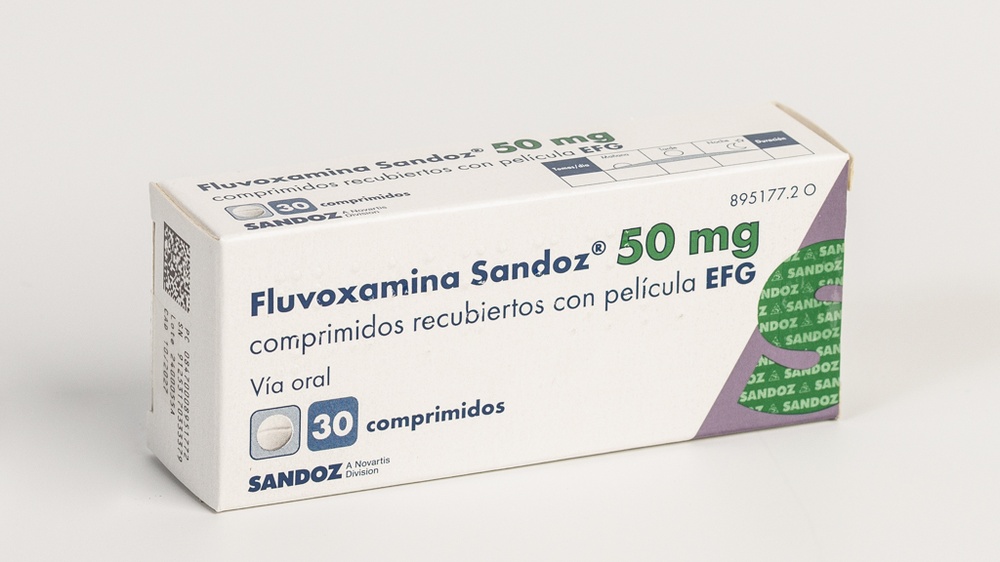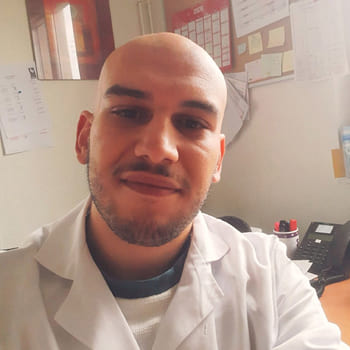

FLUVOXAMINE SANDOZ 50 mg FILM-COATED TABLETS

Ask a doctor about a prescription for FLUVOXAMINE SANDOZ 50 mg FILM-COATED TABLETS

How to use FLUVOXAMINE SANDOZ 50 mg FILM-COATED TABLETS
Introduction
Package Leaflet: Information for the User
Fluvoxamine Sandoz 50 mg film-coated tablets EFG
Fluvoxamine Sandoz 100 mg film-coated tablets EFG
Fluvoxamine maleate
Read all of this leaflet carefully before you start taking this medicine because it contains important information for you.
- Keep this leaflet, you may need to read it again.
- If you have any further questions, ask your doctor or pharmacist.
- This medicine has been prescribed for you only. Do not pass it on to others. It may harm them, even if their signs of illness are the same as yours.
- If you get any side effects, talk to your doctor or pharmacist. This includes any possible side effects not listed in this leaflet. See section 4.
Contents of the pack
- What is Fluvoxamine Sandoz and what is it used for
- What you need to know before you take Fluvoxamine Sandoz
3 How to take Fluvoxamine Sandoz
4 Possible side effects
- Storage of Fluvoxamine Sandoz
- Contents of the pack and other information
1. What is Fluvoxamine Sandoz and what is it used for
Fluvoxamine Sandoz belongs to a group of medicines called selective serotonin reuptake inhibitors (SSRIs). Fluvoxamine Sandoz contains the active substance fluvoxamine. It is an antidepressant.
It is used for the treatment of depression (major depressive disorder).
Fluvoxamine Sandoz can also be used to treat people who suffer from obsessive-compulsive disorder (OCD).
2. What you need to know before you take Fluvoxamine Sandoz
Do not take Fluvoxamine Sandoz if:
- you are allergic to fluvoxamine or any of the other ingredients of this medicine (listed in section 6),
- you are taking medicines called monoamine oxidase inhibitors (MAOIs) sometimes prescribed for depression or anxiety, including linezolid (an antibiotic that is also an MAOI). Treatment with fluvoxamine should only be started at least 2 weeks after stopping an irreversible MAOI. However, treatment with fluvoxamine after stopping certain reversible MAOIs can be started on the next day. In exceptional cases, linezolid (an antibiotic MAOI) can be used with fluvoxamine if your doctor closely supervises you. Your doctor will tell you how to start taking fluvoxamine once you have stopped taking the MAOI,
- you are taking tizanidine, a medicine used as a muscle relaxant,
- if you are taking pimozide, an antipsychotic medicine used in the treatment of schizophrenia and other psychiatric disorders,
- you are breast-feeding.
If any of the above applies to you, do not takefluvoxamine and consult your doctor.
Warnings and precautions
Consult your doctor or pharmacist before starting to take Fluvoxamine Sandoz if:
- you have recently had a heart attack,
- you are pregnant, or think you might be pregnant,
- you suffer from epilepsy,
- you have a history of bleeding problems or if you regularly take medicines that increase the risk of bleeding, such as painkillers, or if you are pregnant (see “Pregnancy, breast-feeding and fertility”),
- you suffer from diabetes,
- you are undergoing electroconvulsive therapy (ECT),
- you have a history of having suffered from mania (feeling of euphoria or overexcitement),
- you suffer from liver or kidney problems,
- you have high blood pressure in the eyes (glaucoma),
- you are under 18 years old (see also section 3),
- if you are taking medicines containing buprenorphine or buprenorphine/naloxone, as these products taken in combination with fluvoxamine can cause serotonin syndrome, a potentially life-threatening condition (for symptoms, see section 4, "Possible side effects") and also "Other medicines and Fluvoxamine Sandoz".
If any of the above applies to you, your doctor will decide whether it is safe for you to start taking fluvoxamine.
Medicines like Fluvoxamine Sandoz (so-called SSRIs) may cause symptoms of sexual dysfunction (see section 4). In some cases, these symptoms have continued after stopping treatment.
Occasionally, ideas of restlessness,cannot sit or stand still (akathisia) may occur or increase in the first few weeks of treatment with fluvoxamine, until the antidepressant effect occurs.
Inform your doctor immediately if you have these symptoms. It may be helpful to adjust the dose.
Severe skin reactions have been reported when using fluvoxamine. Stop taking fluvoxamine and contact a doctor immediately if you develop a rash or ulcers in the mucous membranes. Severe skin reactions may include skin rash, which starts in the hands, feet, arms or legs, usually on both sides of the body and evolving in concentric circles resembling erythema (erythema multiforme), generalized rash with blisters and skin peeling, occurring mainly around the mouth, nose, eyes, and genitals (Stevens-Johnson syndrome), extensive skin peeling (more than 30% of the body surface - toxic epidermal necrolysis).
Suicidal thoughts and worsening of your anxiety or depression:
If you are depressed and/or experience anxiety disorders, you may experience thoughts of self-harm or suicide. This can increase when you first start taking antidepressant treatment, as these medicines take time to work, usually about two weeks, but sometimes longer.
You are more likely to think this way:
- if you have had previous thoughts of suicide or self-harm,
- if you are a young adult. Information from clinical trials has shown an increased risk of suicidal behavior in adults under 25 years with psychiatric disorders who were treated with an antidepressant.
If you have thoughts of self-harm or suicide, inform your doctor immediately or go directly to a hospital.
It may be helpful to tell a relative or friendthat you are feeling depressed or have an anxiety disorder, and ask them to read this leaflet.
You can ask them their opinion on whether you are getting worse, or if they are worried about the changes in your behavior.
Inform your doctor immediatelyif you have ideas or experiences that distress you.
Children and adolescents under 18 years
Children and adolescents under 18 years should not take this medicine, unless they are being treated for obsessive-compulsive disorder (OCD). This is because fluvoxamine is not used to treat depression in people under 18 years.
When they take this type of medicine, patients under 18 years have an increased risk of side effects such as attempted suicide, suicidal thoughts, and hostility, such as aggression, confrontational behavior, and irritability.
If your doctor has prescribed fluvoxamine to a patient under 18 years and you want to discuss this decision, go back to your doctor. If a patient under 18 years is taking fluvoxamine, you must inform your doctor if any of the symptoms mentioned above get worse or if you have complications.
There is no information on the long-term safety of fluvoxamine in children and adolescents under 18 years regarding growth, maturation, and cognitive and behavioral development.
Other medicines and Fluvoxamine Sandoz
Tell your doctor or pharmacist if you are taking, have recently taken, or might take any other medicines.
- Do not start taking the herbal remedy St. John's Wort if you have been prescribed fluvoxamine, as it may increase the risk of side effects. If you are already taking St. John's Wort preparations when you start treatment with fluvoxamine, stop taking St. John's Wort and consult your doctor at your next visit.
- if you have been taking a medicine for depression or anxiety during the last two weeks or suffer from schizophrenia, consult your doctor or pharmacist.
Your doctor or pharmacist should know if you are taking other medicines for depression or related conditions, which contain:
- benzodiazepines,
- tricyclic antidepressants,
- neuroleptics or antipsychotics,
- lithium,
- tryptophan,
- monoamine oxidase inhibitors (MAOIs) such as moclobemide,
- piomizide,
- selective serotonin reuptake inhibitors (SSRIs) such as citalopram.
Your doctor will tell you if it is safe for you to start taking fluvoxamine.
Tell your doctor or pharmacist if you are taking any of the following medicines:
- aspirin (acetylsalicylic acid) or similar medicines used to treat pain and inflammation (arthritis),
- cyclosporin, used to reduce the activity of the immune system,
- methadone, used to treat pain and withdrawal syndrome,
- mexiletine, used to treat heart rhythm disorders,
- phenytoin or carbamazepine, used to treat epilepsy,
- propranolol, used to treat high blood pressure and heart disorders,
- ropinirole, for Parkinson's disease,
- a "triptan", used to treat migraines, such as sumatriptan,
- terfenadine, used to treat allergies. Fluvoxamine should not be used in combination with terfenadine,
- sildenafil, used to treat erectile dysfunction,
- theophylline, used to treat asthma and bronchitis,
- tramadol, used to treat pain,
- buprenorphine or buprenorphine/naloxone,
- clopidogrel, warfarin, acenocoumarol, or any anticoagulant medicine.
If you are taking or have recently taken any of the medicines listed above and have not informed your doctor, go back to your doctor and ask what you should do. Your doctor may change your dose or may need to give you a different medicine.
Taking Fluvoxamine Sandoz with food, drinks, and alcohol
- do not drink alcoholic beverages if you are taking this medicine. Alcohol may interact with fluvoxamine and cause drowsiness and instability.
- if you normally drink a lot of tea, coffee, or soft drinks containing caffeine, you may experience symptoms such as shaky hands, discomfort, rapid heartbeat (palpitations), restlessness, and difficulty sleeping (insomnia). If you reduce the amount of caffeine you drink, these symptoms may disappear.
Pregnancy, breast-feeding, and fertility
If you are pregnant or breast-feeding, think you may be pregnant, or are planning to have a baby, ask your doctor or pharmacist for advice before taking this medicine.
Pregnancy
There is only limited experience with the use of fluvoxamine during pregnancy. Do not take fluvoxamine if you are pregnant unless your doctor considers it absolutely necessary. If you are currently taking fluvoxamine and are planning to become pregnant, please consult your doctor to see if it is necessary or appropriate to change your medication.
Make sure your midwife and/or doctor know that you are being treated with fluvoxamine. If fluvoxamine is taken during pregnancy, especially during the last 3 months, medicines like fluvoxamine may increase the risk of a serious condition in the baby called persistent pulmonary hypertension of the newborn (PPHN), which makes the baby breathe faster and appear blue. These symptoms usually start during the first 24 hours after the baby is born. If this happens to your baby, you should inform your midwife and/or doctor immediately.
Do not stop taking fluvoxamine suddenly. If you have been taking fluvoxamine during the last 3 months of pregnancy, your baby may have other symptoms when born, in addition to difficulty breathing or blue skin, such as not being able to sleep or feed properly, being too hot or cold, feeling unwell, crying a lot, stiff or floppy muscles, lethargy, drowsiness, tremors, becoming nervous or having seizures.
If your baby has any of these symptoms when born, consult your doctor immediately.
If you take Fluvoxamine Sandoz in the final stages of pregnancy, there may be an increased risk of heavy vaginal bleeding after giving birth, especially if you have a history of bleeding disorders. Your doctor or midwife should know that you are taking Fluvoxamine Sandoz so that they can advise you.
Breast-feeding
Fluvoxamine passes into breast milk. There is a risk of an effect on the newborn. Therefore, you should discuss with your doctor whether you should stop breast-feeding or stop taking fluvoxamine.
Driving and using machines
You can drive and use machines while taking this treatment, as long as this medicine does not make you feel drowsy.
Fluvoxamine Sandoz contains sodium
This medicine contains less than 1 mmol of sodium (23 mg) per tablet; this is, essentially “sodium-free”.
3. How to take Fluvoxamine Sandoz
Follow exactly the administration instructions of this medicine given by your doctor or pharmacist. In case of doubt, consult your doctor or pharmacist again.
Usual initial dose for adults (18 years and over)
Treatment of depression
- Start with 50 or 100 mg daily, taken at night.
Treatment of obsessive-compulsive disorder
- Start with 50 mg daily, preferably taken at night.
If you do not start to feel better after a couple of weeks, consult your doctor, who will advise you and decide whether it is necessary to gradually increase your dose.
The maximum recommended daily dose is 300 mg.
If your doctor tells you to take more than 150 mg per day, do not take itall at once, consult your doctor when you should take it.
Usual dose in children and adolescents with obsessive-compulsive disorder (8 years and over):
- Start with 25 mg (half a tablet) per day. Your doctor may increase the dose every 4-7 days by 25 mg as tolerated until an effective dose is reached.
- The maximum daily dose is 200 mg.
If your doctor tells you to take more than 50 mg per day, do not take it all at once, consult your doctor when you should take it. If it is not divided into equal doses, the larger dose should be taken at night.
Children and adolescents under 18 years should not takethis medicine to treat depression. This medicine should onlybe prescribed for children and adolescents with obsessive-compulsive disorder (OCD).
How to take Fluvoxamine Sandoz
Swallow the tablets with water. Do notchew the tablets.
You can split the tablets in half if your doctor has told you to do so.
When it takes effect
Fluvoxamine takes some time to work. Some patients do not feel better during the first 2 or 3 weeks of treatment.
Continue takingthe tablets until your doctor tells you to stop. Even if you feel better, your doctor may advise you to continue taking the tablets for some time, at least six months, to make sure the medicine has worked completely.
Do notstop taking fluvoxamine suddenly. You may experience withdrawal symptomssuch as:
- agitation and anxiety,
- confusion,
- diarrhea,
- difficulty sleeping/sleeping intensely,
- dizziness,
- emotional instability,
- headache,
- irritability,
- nausea and/or vomiting,
- palpitations (accelerated heartbeats),
- sensory disturbances (such as electric shock sensation or visual disturbances),
- sweating,
- tremors.
When stopping treatment with fluvoxamine, your doctor will help you reduce your dose gradually over weeks or months, which will help reduce the possibility of experiencing withdrawal symptoms. Most patients find that these fluvoxamine withdrawal symptoms are mild and will disappear on their own within two weeks; however, for some patients, these symptoms may be more severe or may last longer.
If you experience withdrawal symptoms when stopping the tablets, your doctor will decide whether you should stop them more slowly. If you experience severe withdrawal symptoms when stopping fluvoxamine, please inform your doctor, who will tell you whether you should start taking the treatment again and stop it gradually (see section 4 "Possible side effects").
If you experience any symptoms when stopping treatment, contactyour doctor.
If you take more Fluvoxamine Sandoz than you should
If you have taken more fluvoxamine than you should, consult your doctor, pharmacist, or call the Toxicology Information Service, phone: 91 562 04 20, indicating the medicine and the amount used. Bring the medicine package with you.
Symptoms of overdose include, but are not limited to, nausea, vomiting, diarrhea, and feeling drowsy or dizzy. Cardiac symptoms (slow or fast heart rate, low blood pressure), liver complications, seizures (attacks), and coma have been reported.
If you forget to take Fluvoxamine Sandoz
If you forget to take a tablet, wait until the next dose. Do not take a double dose to make up for the forgotten dose.
If you have any other questions about the use of this medicine, ask your doctor or pharmacist.
4. Possible Adverse Effects
Like all medicines, this medicine can cause adverse effects, although not all people suffer from them.
Adverse Effects Related to this Type of Medication
Occasionally, suicidal thoughts or self-harmmay occur or increase during the first weeks of treatment with fluvoxamine, until the antidepressant effect occurs.
Inform your doctor immediatelyif you have ideas or experiences of distress.
If you have several symptoms at the same time, it may be that you have one of the rare conditions described below:
- Serotonin syndrome: if you have sweating, muscle stiffness or spasms, instability, confusion, irritability or extreme agitation.
- Malignant neuroleptic syndrome: if you have muscle stiffness, fever, confusion, and other related symptoms.
- SIADH: if you feel tired, weak, or confused and have painful, numb, or uncontrolled muscles.
- Severe skin reactions, such as severe skin rashes or redness, including generalized rash, which starts on the hands, feet, arms, or legs on both parts of the body and evolves into concentric circles that resemble erythema (erythema multiforme), generalized skin rash with blisters and skin peeling, which occurs especially around the mouth, nose, eyes, and genitals (Stevens-Johnson syndrome), extensive skin peeling (more than 30% of the body surface - toxic epidermal necrolysis). The frequency of these secondary effects is unknown (cannot be estimated from the available data).
Stoptaking fluvoxamine and consult your doctor immediately.
If you have unusual bruises or purple spots on your skin or if you vomit blood or have blood in your stool, contact your doctor.
Stopping fluvoxamine (especially when done abruptly) often leads to withdrawal symptoms (see section 3 withdrawal symptoms).
Sometimes patients have nauseawhen starting treatment with fluvoxamine, as it begins to take effect. Although the feeling of nausea is unpleasant, it should pass soon if you continue taking the tablets as prescribed. This may occur within a few weeks.
Adverse Effects Caused by Fluvoxamine
Adverse EffectsFrequent(may affect up to 1 in 10 patients):
- restlessness,
- anxiety,
- constipation,
- diarrhea,
- difficulty falling asleep,
- dizziness,
- dry mouth,
- accelerated heart rate,
- feeling of sleepiness (lethargy),
- feeling of discomfort,
- headache,
- indigestion,
- loss of appetite,
- nervousness,
- stomach pain,
- sweating,
- tremors,
- muscle weakness (asthenia),
- vomiting,
Adverse EffectsUncommon(may affect up to 1 in 100 patients):
- allergic reactions (including swelling of the face, lips, or tongue, rash, itching),
- confusion,
- aggression
- delayed ejaculation,
- dizziness when standing up/getting up quickly,
- hallucinations,
- lack of coordination,
- muscle or joint pain.
Adverse EffectsRare(may affect up to 1 in 1,000 patients):
- seizures,
- liver problems,
- mania (feeling of euphoria or overexcitement),
- sensitivity to sunlight,
- unexpected milk secretion from the breasts.
Frequency Not Known(cannot be estimated from the available data):
Abundant vaginal bleeding shortly after childbirth (postpartum hemorrhage), see "Pregnancy, Breastfeeding, and Fertility" in section 2 for more information.
Other Adverse Reactions Reported:
- akathisia (restlessness),
- abnormal taste,
- anorgasmia (inability to reach orgasm),
- for female patients: menstrual disorders (menstruation),
- urinary disorders (such as frequent need to urinate during the day and/or night, sudden lack of control over urination during the day and/or night, or inability to urinate),
- paresthesia (tingling or numbness),
- glaucoma (increased pressure in the eye),
- dilated pupils,
- increased prolactin hormone (a hormone that supports milk production in a breastfeeding mother),
- weight changes.
A higher risk of bone fractures has been observed in patients taking this type of medication.
Adverse Reactions Related to Treatment for Obsessive-Compulsive Disorder (OCD) in Children and Adolescents, Whose Frequency is Not Established.
- hypomania (feeling of euphoria and overexcitement),
- agitation,
- seizures,
- difficulty falling asleep (insomnia),
- lack of energy (asthenia),
- hyperactivity (hyperkinesia),
- feeling of sleepiness (somnolence),
- indigestion.
Reporting of Adverse Effects
If you experience any type of adverse effect, consult your doctor or pharmacist, even if it is a possible adverse effect that does not appear in this prospectus. You can also report them directly through the Spanish Pharmacovigilance System for Human Use Medicines: https://www.notificaram.es. By reporting adverse effects, you can contribute to providing more information on the safety of this medicine.
5. Conservation of Fluvoxamine Sandoz
Keep this medicine out of sight and reach of children.
Do not use this medicine after the expiration date that appears on the packaging after CAD/EXP. The expiration date is the last day of the month indicated.
Do not store at a temperature above 25°C. Store in the original packaging.
Medicines should not be thrown away through the sewers or in the trash. Deposit the packaging and medicines that you no longer need in the SIGRE Point of the pharmacy. In case of doubt, ask your pharmacist how to dispose of the packaging and medicines that you no longer need. This way, you will help protect the environment.
6. Content of the Packaging and Additional Information
Composition of Fluvoxamine Sandoz 50 mg
- The active ingredient is fluvoxamine (as maleate). Each film-coated tablet contains 50 mg of fluvoxamine (as maleate).
Composition of Fluvoxamine Sandoz 100 mg
- The active ingredient is fluvoxamine (as maleate). Each film-coated tablet contains 100 mg of fluvoxamine (as maleate).
The other components are:
- Core of the tablet: corn starch, mannitol (E 421), pregelatinized corn starch, colloidal anhydrous silica, sodium stearyl fumarate.
- Coating of the tablet: macrogol 6000, talc (E 553b), titanium dioxide (E 171), hypromellose (E 464).
Appearance of the Product and Content of the Packaging
Fluvoxamine Sandoz 50 mg:
They are white to off-white, round, biconvex, scored tablets, marked with "FLM 50" on one side.
Fluvoxamine Sandoz 100 mg:
They are white to off-white, round, biconvex, scored tablets, marked with "FLM 100" on one side.
This product is presented in ALU/PVC/PVDC blisters inserted in a cardboard box.
Packaging sizes:
10, 20, 30, 50, 60, 90, 100 film-coated tablets.
Only some packaging sizes may be marketed.
Marketing Authorization Holder and Manufacturer
Marketing Authorization Holder
Sandoz Farmacéutica, S.A.
Centro Empresarial Parque Norte
Edificio Roble
C/ Serrano Galvache, 56
28033 Madrid
Spain
Manufacturer
Sandoz B.V.
Veluwezoom 22
1327 AH Almere
Netherlands
or
Synthon Hispania, S.L.
Castello, 1
Poligono Las Salinas
08830 Sant Boi de Llobregat
Spain
This medicine is authorized in the member states of the European Economic Area with the following names:
Netherlands:Fluvoxaminemaleaat Sandoz 50
Fluvoxaminemaleaat Sandoz 100
Date of the Last Revision of this Prospectus:January 2024
Detailed information about this medicine is available on the website of the Spanish Agency for Medicines and Health Products (AEMPS) http://www.aemps.gob.es/

How much does FLUVOXAMINE SANDOZ 50 mg FILM-COATED TABLETS cost in Spain ( 2025)?
The average price of FLUVOXAMINE SANDOZ 50 mg FILM-COATED TABLETS in December, 2025 is around 3.84 EUR. Prices may vary depending on the region, pharmacy, and whether a prescription is required. Always check with a local pharmacy or online source for the most accurate information.
- Country of registration
- Average pharmacy price3.84 EUR
- Active substance
- Prescription requiredYes
- Manufacturer
- This information is for reference only and does not constitute medical advice. Always consult a licensed doctor before taking any medication. Oladoctor is not responsible for medical decisions based on this content.
- Alternatives to FLUVOXAMINE SANDOZ 50 mg FILM-COATED TABLETSDosage form: TABLET, 100 mg of fluvoxamine maleateActive substance: fluvoxamineManufacturer: Viatris Healthcare LimitedPrescription requiredDosage form: TABLET, 50 mg of fluvoxamine maleateActive substance: fluvoxamineManufacturer: Viatris Healthcare LimitedPrescription requiredDosage form: TABLET, 100 mg fluvoxamine maleateActive substance: fluvoxamineManufacturer: Sandoz Farmaceutica S.A.Prescription required
Alternatives to FLUVOXAMINE SANDOZ 50 mg FILM-COATED TABLETS in other countries
The best alternatives with the same active ingredient and therapeutic effect.
Alternative to FLUVOXAMINE SANDOZ 50 mg FILM-COATED TABLETS in Poland
Alternative to FLUVOXAMINE SANDOZ 50 mg FILM-COATED TABLETS in Ukraine
Online doctors for FLUVOXAMINE SANDOZ 50 mg FILM-COATED TABLETS
Discuss dosage, side effects, interactions, contraindications, and prescription renewal for FLUVOXAMINE SANDOZ 50 mg FILM-COATED TABLETS – subject to medical assessment and local rules.









